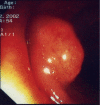Pneumatosis cystoides intestinalis
- PMID: 22171137
- PMCID: PMC3235639
- DOI: 10.3748/wjg.v17.i44.4932
Pneumatosis cystoides intestinalis
Abstract
Pneumatosis cystoides intestinalis (PCI) is a rare condition that may be associated with a variety of diseases. The presenting clinical picture may be very heterogeneous and represent a challenge for the clinician. In the present paper we describe both a common and an uncommon clinical presentation of PCI and review the pertaining literature. Our cases confirm that, apart from asymptomatic cases, the clinical presentation of PCI may be widely different and suggest that a new onset of stipsis might be the presenting symptom. Diagnosis might be suggested by a simple X-ray of the digestive tract showing a change in the characteristics of the intestinal wall in two-thirds of these patients. However, one third of the patients do not have a suggestive X-ray and require a computed tomography (CT) scan/nuclear magnetic resonance that may reveal a thickened bowel wall containing gas to confirm the diagnosis and distinguish PCI from intraluminal air or submucosal fat. CT also allows the detection of additional findings that may suggest an underlying, potentially worrisome cause of PCI such as bowel wall thickening, altered contrast mucosal enhancement, dilated bowel, soft tissue stranding, ascites and the presence of portal air. Our results also point out that clinicians and endoscopists should be aware of the possible presentations of PCI in order to correctly manage the patients affected with this disease and avoid unnecessary surgeries. The increasing number of colonoscopies performed for colon cancer screening makes PCI more frequently casually encountered and/or provoked, therefore the possible endoscopic appearances of this disease should be well known by endoscopists.
Keywords: Endoscopy; Hyperbaric oxygen; Pneumatosis cystoides intestinalis; Pneumoperitoneum; Treatment.
Figures
References
-
- Groninger E, Hulscher JB, Timmer B, Tamminga RY, Broens PM. Free air intraperitoneally during chemotherapy for acute lymphoblastic leukemia: consider pneumatosis cystoides intestinalis. J Pediatr Hematol Oncol. 2010;32:141–143. - PubMed
-
- Clemente G, Chiarla C, Giovannini I, De Rose AM, Astone A, Barone C, Nuzzo G. Gas in portal circulation and pneumatosis cystoides intestinalis during chemotherapy for advanced rectal cancer. Curr Med Res Opin. 2010;26:707–711. - PubMed
-
- McCollister DL, Hammerman HJ. Air, air, everywhere: pneumatosis cystoides coli after colonoscopy. Gastrointest Endosc. 1990;36:75–76. - PubMed
Publication types
MeSH terms
LinkOut - more resources
Full Text Sources
Miscellaneous



